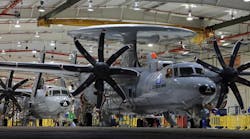The U.S. Air Force placed a $114-million contract with Northrop Grumman Corporation to build three more RQ-4 Global Hawk unmanned aerial vehicle, and associated sensors. The intelligence, surveillance and reconnaissance (ISR) aircraft is used by U.S. military commanders to receive high-resolution images, survey geography — up to 40,000 square miles of terrain per day — and pinpoint targets on the ground.
The UAV concept emerged about 15 years ago, and the first Global Hawk took flight in 1998. The U.S. Navy and U.S. Air Force operate variants of the base technology for intelligence collection in support military operations worldwide. However, as costs for the aircraft have increased above initial forecasts (from $35 million in 2005 to $222.7 million per aircraft now) the DoD has reduced its planned purchases from 63 to 45.
Northrop Grumman’s new contract provides for advance procurement of long-lead items for three Block 30 aircraft, including three enhanced integrated sensor suites, three airborne signals intelligence payload (ASIP), and two ASIP retrofit kits to be installed on previously purchased aircraft.
The work associated with this contract is expected to be completed in 2015.
"Global Hawk's ability to fly more than 30 hours at high altitudes while gathering multiple types of intelligence data makes it extremely valuable to field commanders who need near real-time information," stated George Guerra, Northrop Grumman's vice president for Global Hawk UAS. "This award is especially important because it reaffirms the Air Force's commitment to this safe and cost-effective system, which has been supporting our warfighters for more than 15 years in the U.S. and abroad."
In addition to over 100,000 flight hours for UAVs over battlefields in Iraq, Afghanistan, and Libya, Northrop Grumman pointed to the aircrafts’ work in ISR after earthquakes in Haiti and Japan. It further noted that NASA has used Global Hawks for scientific and environmental research, flying over recent hurricanes as part of a broader study of tropical storms.







